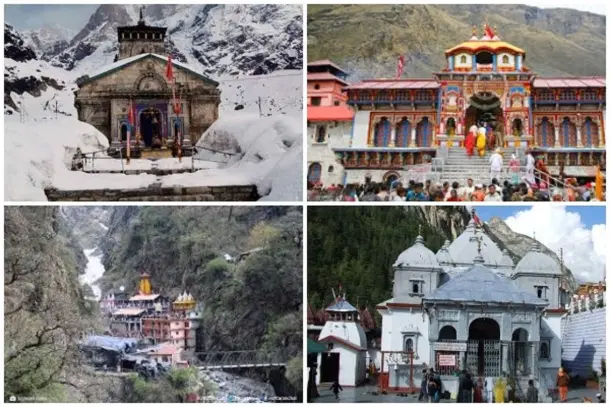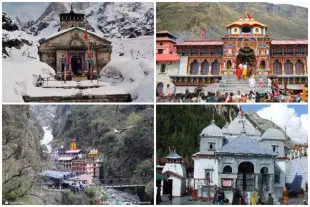News Brief
NGT Recommends Measures To Curb Ecological Destruction Caused During Char Dham Yatra
Arun Kumar Das
Jan 14, 2023, 01:51 PM | Updated 01:56 PM IST
Save & read from anywhere!
Bookmark stories for easy access on any device or the Swarajya app.


A committee appointed by the National Green Tribunal (NGT) highlighted "gross mismanagement" and "lack of infrastructure" in its latest report, making scathing observations about the state of affairs in the four pilgrim tracks in Uttarakhand.
A comprehensive assessment report was submitted on 13 January by the Joint Committee appointed by the NGT to examine the colossal scale of ecological destruction in the pilgrim track regions of Uttarakhand.
Four pilgrim track routes - Kedarnath, Gangotri, Yamunotri and Hemkund Sahib were assessed by the Committee.
Observations made by the Committee concerned gross mismanagement of solid waste, liquid waste and plastic waste pollution, the appalling lack of infrastructure to deal with the huge influx of pilgrims and tourist population during peak seasons in Uttarakhand.
A common practice executed by Zilla Panchayats of the respective pilgrim track regions involved the dumping of solid and plastic waste into Nagar Palika trenching areas in flagrant violation of the Solid Waste Management Rules, 2016 and Plastic Waste Management Rules, 2016.
Overflowing soak pit toilets, insufficient number of public toilets, poor strength of manpower (sweepers) to clean the tracks, non-existent disposal mechanism to deal with equine dung, wastewater and equine carcasses and the overall lack of regulation of the number of equines plying the track.
According to the report, 15,63,278 pilgrims visited Kedarnath track from May 2022 to October 2022.
An average of 2,60,546 pilgrims visited Kedarnath in a month, exceeding the State Government mandated cap of 13,000 pilgrims per month by nearly 20 times.
Zilla Panchayat of Rudraprayag District has employed only 80 sweepers to clean the 18 km long Kedarnath track - which is grossly insufficient to deal with the additional pilgrim footfalls and equine traffic in 2022.
Total 4,85,688 pilgrims visited Gangotri and Yamunotri tracks from May 2022 to October 2022. An average of 80,948 pilgrims visited Gangotri and Yamunotri tracks in a month, exceeding the State Government mandated cap of 8,000 pilgrims per month (for Gangotri track) and 5,000 pilgrims per month (for Yamunotri track) by nearly 5 times.
Zilla Panchayat of Uttarkashi District has employed only 47 sweepers to clean the 32 km long Gangotri - Yamunotri tracks.
According to the report, a total 2,55,000 pilgrims visited Hemkund Sahib track from May 2022 to October 2022.An average of 42,500 pilgrims visited Hemkund Sahib track in a month. Only 46 sweepers have been employed by Zilla Panchayat of Chamoli District to clean the 19 km long Hemkund Sahib track, a number inadequate to deal with the overburdened influx of pilgrim tourists in the region.
The Joint Committee in its report recommended actionable measures including regulating equine entry, commensurate with carrying capacity of the region, management and monitoring of equine health.
Provision of a team of veterinarians to look into equine care and prevent animal abuse, establishment of equine housing facilities in compliance with the Bureau of Indian Standards (BIS) Code of Practice for Equine Housing, 1964, was also suggested.
It also recommended site-specific solid waste segregation, collection, transportation and management with use of bio composting pits, regular monitoring and data collection of soil and water quality, and the commissioning of a scientific study on the impact of tourism on biodiversity losses in the region.
The committee stressed on the enforcement of Solid Waste Management Rules 2016 and Plastic Waste Management Rules, 2016 through regular surveillance.
"It is high time that stringent and time-bound measures are undertaken by the Government of Uttarakhand to protect the ecological sanctity of fragile eco-sensitive areas encompassed by the Char Dham Yatra" observed Gauri Maulekhi, Member Secretary, People For Animals Uttarakhand.
Maulekhi said, "Pinning responsibility for preventing environmental degradation on the Zilla Panchayats of the districts of Rudraprayag, Uttarkashi and Chamoli is a step in the right direction. However, it is also important in principle to impose both a duty and a cost on the District Administration of these districts because hefty revenue is earned by the administration from the exercise of registration of equines and granting of permissions for the plying of equine traffic”.
Urvashi Shobhna Kachari, the petitioner in the case and Member Secretary, Consumers For Sustainability, said "The acknowledgement of massive pollution in the pilgrim track regions of Uttarakhand and the documentation of disastrous pollution on the ground by the fact finding committee justifies the need for urgent policy intervention".
"It is also progressive of the NGT appointed committee to have the foresight of highlighting the lack of veterinary infrastructure and equine shelters, the flogging of equines through excessive excursions without adequate rest and the improper disposal of equine carcasses with implications on public health. Thereby, undertaking a holistic one health approach that interlinks environmental sustainability with public health as well as the welfare and health of equines” she added.
The matter will be heard by the NGT on 25 January 2023 wherein the Joint Committee Report (drafted by scientific experts from Central Pollution Control Board, Uttarakhand State Pollution Control Board and GB Pant National Institute of Himalayan Environment) will be assessed by the Principal Bench.
Arun Kumar Das is a senior journalist covering railways. He can be contacted at akdas2005@gmail.com.




